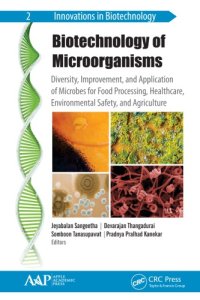
Ebook: Biotechnology of microorganisms: diversity, improvement, and application of microbes for food processing, health sector, environmental safety, and agricultural industry
- Tags: Industrial Microbiology, Microbial biotechnology, SCIENCE / General, SCIENCE / Life Sciences / Biochemistry, SCIENCE / Biotechnology
- Series: Innovations in biotechnology volume 2
- Year: 2020
- Publisher: Apple Academic Press
- Language: English
- pdf
"Microbial biotechnology is an important contributor to global business, especially in agriculture, the environment, healthcare and medicine, food, and chemical industries. This volume provides an exciting interdisciplinary journey through the rapidly changing backdrop of invention in microbial biotechnology, covering a range to topics, including microbial properties and characterization, cultivation and production Read more...
Abstract: "Microbial biotechnology is an important contributor to global business, especially in agriculture, the environment, healthcare and medicine, food, and chemical industries. This volume provides an exciting interdisciplinary journey through the rapidly changing backdrop of invention in microbial biotechnology, covering a range to topics, including microbial properties and characterization, cultivation and production strategies, and applications in healthcare, bioremediation, nanotechnology, and more. Microbial intervention is an important topic in biotechnology today. The mapping of microbial genomes is a key technology for comprehending microorganisms and for developing ways to improve their use in agricultural production, food safety, and pharmaceuticals. Microbial biotechnology has led to breakthroughs such as improved vaccines, better disease-diagnostic tools, improved microbial agents for biological control of plant and animal pests, modifications of plant and animal pathogens for reduced virulence, development of new industrial catalysts and fermentation organisms, and new microbial agents for bioremediation of soil and water. This volume will serve as a rich resource for students, researchers, academicians, and industry professionals. Key features: Explains the diverse aspects of and strategies for cultivation of microbial species Describes biodiversity and biotechnology of microbes Provides an understanding of microorganisms in bioremediation of pollutants Explores various applications of microbes in agriculture, food, health, industry, and the environment Considers production issues and applications of microbial secondary metabolites Underscores the importance of integrating genomics of microorganisms in ecological restoration of contaminated environments."